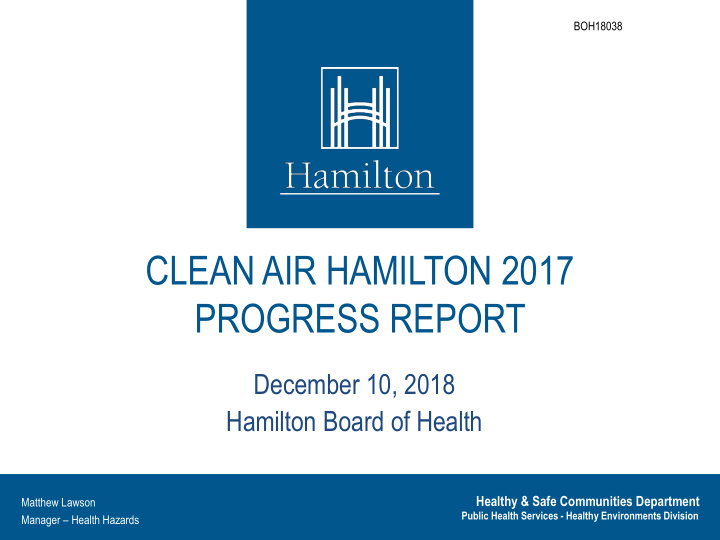



BOH18038 CLEAN AIR HAMILTON 2017 PROGRESS REPORT December 10, 2018 Hamilton Board of Health Healthy & Safe Communities Department Matthew Lawson Public Health Services - Healthy Environments Division Manager – Health Hazards
Bruce Newbold, Ph.D. Chair Clean Air Hamilton www.cleanairhamilton.ca
Clean Air Hamilton Members: Local Citizens Ontario MECP Health Canada Environment Canada ArcelorMittal Dofasco Stelco Lung Association Green Venture McMaster University Mohawk College • Science based / Diverse / Inclusive / Facilitated Consensus MIEH CAH established as an implementation committee to act on • Environment Hamilton recommendations contained in 1997 HAQI Reports City of Hamilton • Community based initiatives Public Health Internationally recognized • Planning Public Works
Hamilton’s Air Quality Trends · Total suspended particulate (TSP) – 57% total reduction over 20 years · Inhalable particulate matter (PM 10 ) – 37% total reduction over 20 years · Respirable particulate matter (PM 2.5 ) – 26% total reduction over 18 years · Nitrogen dioxide (NO 2 ) – 54% total reduction over 20 years · Sulphur dioxide (SO 2 ) – 46% total reduction over 20 years · Total reduced sulphur odours – 98% total reduction over 20 years* · Benzene – 89% total reduction over 20 years** · Polycyclic aromatic hydrocarbons (PAH) measured as benzo[a]pyrene – 78% total reduction over 20 years.** 90% improvement in major pollutants (risk factors ) since 1970s GHG emission reduction targets (2020) met PM 2.5 Canadian Ambient Air Quality Standards (CAAQS) met in 2016
Hamilton’s Air Quality Trends CAAQS 10µg/m 3
Hamilton’s Air Quality Trends Particulate Matter (TSP, PM 10 , PM 2.5 )
Hamilton’s Air Quality Trends Nitrogen Oxides (NO x ) Nitrogen Dioxide (NO 2 ) Ozone (O 3 ) Steady decrease in all major air pollutants except Ozone
Hamilton’s Air Quality Trends Sulphur Dioxide (SO 2 ) Benzene Benzo[a]pyrene Comparisons of ‘Downtown’ sites and ‘Industry’ sites
2017 Community Projects Supported Through Clean Air Hamilton Enhanced Fresh Air for Kids with Anti-Idling • Famous Fresh Air for Kids program with new anti-idling engagement and campaign at participating schools ‘Building’ Community Awareness & Action Regarding Respirable Particulate Pollution in Hamilton • Engage network of volunteer teams across neighbourhoods to help build low cost fine air particulate sensors to become part of a pilot network of real-time monitors
Future 2018 Community Projects Supported Through Clean Air Hamilton Approved at Board of Health meeting May 14, 2018 BOH (BOH18020) Enhanced Fresh Air for Kids with Anti-Idling (Green Venture and Corr Research) • Famous Fresh Air for Kids program with anti-idling engagement and campaign at participating schools. Friendly Streets Hamilton (Cycle Hamilton and Environment Hamilton) • Conducting street-level audits within a 1 km radius of the General hospital while educating the public about air quality challenges and measuring PM 2.5 . Bus For Brains (Green Venture and Dr. Matthew Adams) • Air monitoring completed by students while traveling to school by school bus. Data will be analyzed by Dr. Matthew Adams and his students at UofT.
Future Actions Continue to support and undertake all the recommendations of the Air Quality Task Force (BOH1309) including activities relating to air monitoring, green infrastructure. Support initiatives aimed at reducing transportation related GHG emissions such as: LRT, expansion of HSR services, expansion of bike lanes. Support initiatives aimed at greater connectivity of active transportation such as Downtown Active Superhighway (DASH) and Mountain Active Superhighway (MASH). Support expansion of electric vehicle charging station infrastructure in Hamilton. Continue to support groups like Clean Air Hamilton aimed at improving air quality and public health across the City of Hamilton. Why? To insure the health and well-being of the citizens of Hamilton.
THANK YOU Thank you, On behalf of Clean Air Hamilton
Recommend
More recommend